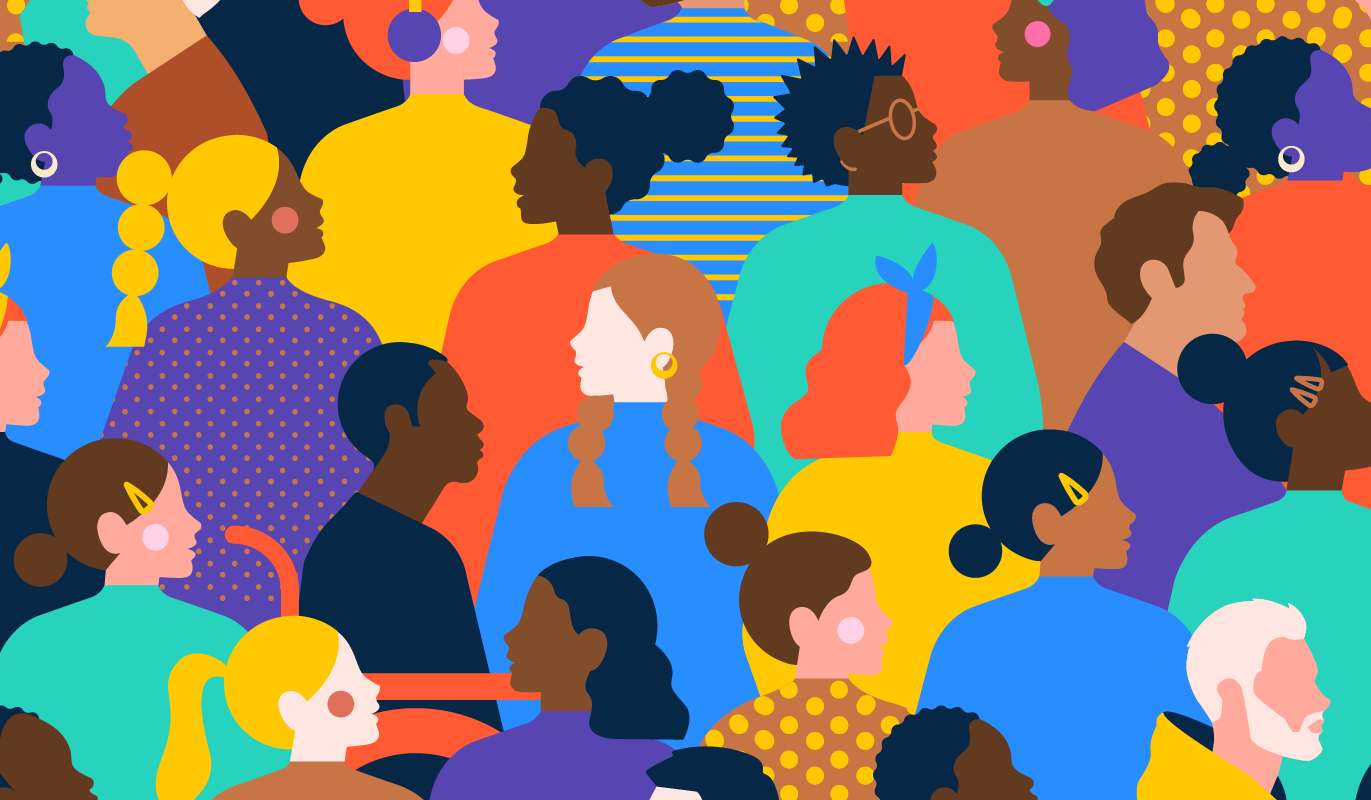October 31, 2022
-4.png?width=400&height=150&name=image%20(1)-4.png) by Amber Pandya / October 31, 2022
by Amber Pandya / October 31, 2022

People are complex. People are complicated.
This is not a revelation if you work in human resources or manage people. In fact, it’s probably why you clicked on this article or googled DEI, in search of clarity and perhaps some answers.
The complexity of people is also what makes HR and managing people fulfilling and rewarding, but simultaneously frustrating and challenging at times. Why? Because if you boil it down: HR is effectively the intersection of revenue and the human condition – two things that are not always aligned.
I’ve worked in the employee engagement space for a long time – 10 years, to be exact. Before leading the Employee Experience team at G2, I spent many years as a consultant. I've tackled a wide variety of HR and people-related issues with clients from industries too numerous to list.
In short, I’ve seen a lot. While each industry, client, and project is different, there was always one topic that incited near-universal fear, nerves, and uncertainty. That topic is DEI.
Diversity, equity, & inclusion (DEI) initiatives in business are implemented to ensure that people of various backgrounds and identities feel represented in the workplace.
According to Glassdoor, 76% of job seekers consider diversity to be an important factor in evaluating job offers. The employee feedback is undeniable, and yet, even the brightest and most experienced business leaders don’t want to touch the topic with a 10-foot pole.
What makes DEI scary is that it’s an aspect of business that is impacted by complex factors that employers are not directly in control of. One could argue that this is also true of macroeconomic trends, such as recessions, where businesses are able to adapt accordingly. But DEI digs deep into the human condition and into the most complex sociopolitical factors, including race, ethnicity, national origin, veteran status, gender identity, sexual orientation, disability, socioeconomic status, and education level.
Effectively, DEI is about life, and you can’t solve life’s problems with a few key metrics and some focus groups.
I’ve worked a long time in the employee engagement space, but I am by no means a DEI expert, nor do I have all the answers. In fact, there are many thought leaders and experts in the DEI field that I admire and turn to for guidance – and they would probably be the first to tell you that they also do not have all the answers.
As G2’s DEI consultant and trusted partner, Myla Skinner often reminds us, “DEI is learning from failure.” It’s an imperfect journey. Frankly, if somebody does claim to have all the answers to DEI, you should probably steer clear.
But what I do want to offer in this article are my thoughts on how DEI has evolved in the past couple of years, why DEI was and still is hard work, as well as the DEI work that we’ve implemented here at G2 – both effective and not so effective.
While I probably won’t be able to answer all of your DEI questions today, I hope you are able to take away some insights as you continue to hone your DEI plans or, if you’re just starting out, build into your business strategy.
There are many diversity-related acronyms that have emerged in recent years, but at G2, we focus on DEI. As such, I want to spend some time breaking down the components of DEI, because although we tend to think of DEI as a singular entity of work, each letter requires its own thoughtful strategy and separate commitment.
Diversity is the representation of different characteristics, experiences, and identity markers. Examples of identities include but are not limited to race, gender, sexual orientation, religion, ethnicity, disability, and age.
Often, diversity training becomes the focus of a DEI program because it’s the most visible, tangible, and easily measurable component. It’s important to keep in mind that after recruiting and hiring diverse employees, there’s a lot more work to do.
At G2, our efforts to diversify our workforce starts with strategic sourcing, key partnerships, and building a diverse pipeline. In 2020, G2 made the commitment to hire more diverse employees, and the first step was to build diversity sourcing into our talent acquisition practices. One way we did this was by focusing on establishing and developing key partnerships with organizations such as Out in Tech and DirectEmployers Association.
These key partnerships help us build a consistent pipeline of diverse talent to fill openings, with a special focus on roles at the manager level and above. Our belief is that the importance of diversity at the higher levels is necessary for mentorship, representation, and advocacy for more junior employees.
It’s important to differentiate equity and equality. Equality is a state where all employees are treated fairly and have access to the same resources and equal opportunities.
Equity is slightly different, in that it takes the disadvantages and obstacles of certain groups or individuals into consideration so everyone can achieve the same outcome.
At G2, we are lucky to have a global team of 700 people, spread across multiple regions, who bring a diversity of backgrounds and experiences to our work community. Some have spent years in tech, others are new to the industry. Some have formal education in engineering, others got their training from non-traditional programs like boot camps. Some are just starting out in their careers, others are more tenured and more well-versed in the ways of the corporate world.
As Director of Employee Experience, part of my job is to ensure that all G2ers feel supported and have the ability to succeed. To do that, we offer programs to promote equity, like our global mentorship program. The mentorship program is a way to offer employees (especially those who identify as women and/or BIPOC) one-on-one guidance and support from a more experienced or tenured person at G2.
We’re also focusing on global pay equity, one of our three key DEI areas of focus for the year. We’ve brought on external consultants with expertise in helping early-stage companies lay the foundation for fair pay, promotion, and performance processes.
We’ve made this commitment to global pay equity because we believe this will help us keep our best talent, attract the best candidates, and become a top global employer – but more importantly, because it aligns with our values, and it’s the right thing to do.
Inclusion is building a work environment where employees feel safe and supported. Without an inclusive workplace culture, employees of underrepresented groups may not feel valued, heard, and respected, which unintentionally creates a harmful cycle of tokenism and turnover.
As the highly respected diversity and inclusion expert Verna Myers explains, "Diversity is being invited to the party; inclusion is being asked to dance." Programs such as employee resource groups, interest groups, DEI training, and learning resources are just a few examples.
Of the three components of DEI, inclusion is the hardest to measure and track. For diversity, you can track race, gender, and age. For equity, you can track outcomes, performance, and compensation. Measuring inclusion is harder because it’s about sentiments and feelings of safety, support, and value.
But here at G2, we’ve been measuring inclusion since 2019 with a metric we call iNPS.
Our iNPS metric is similar to a metric you’re probably familiar with: Employee Net Promoter Score (eNPS), which measures employee engagement and satisfaction. Once a quarter, we do an eNPS pulse survey and ask G2 employees, “Would you recommend G2 as a great place to work?” But we wanted to be able to capture and track inclusion in a similar way.
With the help of an external DEI expert, and using eNPS as our inspiration, we developed a question that we believe captures the most important aspects of inclusivity: “I feel comfortable being myself at work, even when I’m different from others.“ We launched our first Inclusion Net Promoter Score (iNPS) question in November 2019 and continue to measure it every quarter, along with eNPS.
The implementation and calculation of iNPS is identical to that of eNPS. Employees respond with a score of 0 (the lowest) to 10 (the highest). Scores of 0 to 6 are considered detractors, and 9 and 10 are promoters. Scores of 7 and 8 are passives, neither detractors of promoters, and thus do not impact the score.
Because our quarterly pulse surveys include both eNPS and iNPS, it also provides insights into the impact that inclusion has on engagement, and vice versa. It’s probably not a surprise that we’ve come to find, after three years of data, that there is a positive correlation between engagement and inclusion.
It’s important to point out that the creation of our iNPS metric was not based on rigorous academic or industry research. There are no industry standards to measure inclusion in a single metric, but we tapped into our entrepreneurial and innovative spirit to create one based on a method and logic that was already shown to be useful and effective for us.
We can’t say for certain if it’s perfect, but it is how we’re making progress at G2.
Another important learning that should be noted is that a high iNPS score doesn't necessarily mean you’ve nailed inclusion at your company. If a team is homogeneous in its demographics, this could also result in a high iNPS score, so it’s important to analyze the data with the context of additional DEI data. That is why iNPS is just one of many measures we use to gauge our inclusion efforts.
DEI as a practice has been part of corporate America for decades, with its roots going back to the Civil Rights Era and Anti-Discrimination legislation of the 1960s. Until recently, we would hear about it every now and then, around discussions of company culture, and it was generally viewed as a “nice to have '' rather than a priority.
But it all drastically changed in the Spring of 2020. In my opinion, the practice of DEI can really be divided into two eras: pre-George Floyd and post-George Floyd.
The murders of George Floyd, Breonna Taylor, and Ahmaud Arbery, as well as the #BlackLivesMatter movement in the Spring and Summer of 2020 were monumental turning points in the fight for racial justice on a global scale. This period of time was a catalyst for greater awareness, education, and action on DEI because customers and employees alike were voicing their opinions and expecting companies to take a moral and financial stand – and business leaders definitely felt this pressure.
The Harvard Business Review recently studied the impact of George Floyd’s murder and the #BlackLivesMatter movement on corporate DEI efforts in the U.S., using data from interviews with Chief Diversity Officers (CDOs) in 2019 and 2021. The CDOs reported that before the summer of 2020, they felt senior leaders and other key stakeholders provided minimal support. But after the summer of 2020, the CDOs reported that senior leaders saw their work as more pivotal to their companies’ success, and there was more attention and urgency given to DEI issues.
Despite this seismic shift in perspective on DEI, the CDOs said the increase in interest and urgency did not lead to greater resources needed to perform the additional work. DEI initiatives were built into missions and strategies, but at the same time, CDOs reported a lack of true strategic commitment and accountability.
And as with any project or initiative, without accountability, there is unlikely to be meaningful change or impact.
This raises the question: why is there reluctance to commit and stay accountable when it comes to DEI? How do we overcome that reluctance? I asked Myla these two questions, and she similarly tied it back to the idea I raised earlier: it’s about human nature.
"Ultimately, all change is difficult, DEI work notwithstanding, and we are wired not to want to move towards that change when we see more immediate risk than immediate reward.
However, humans are dynamic and complex, so we are capable of change, especially when we know that it will enhance our lives. We must see DEI as the change that will enhance both our lives and our organizations. We must see it as an act of survival."
– Myla Skinner, DEI consultant at G2
DEI is hard because it’s about changing our deeply ingrained human nature, but it is feasible if we see it as a way to survive in the future. A non-negotiable commitment, if you will.
This is why G2 is proud to externally share its DEI commitment statement. Part of the learning and growth journey that G2 has been on the last two years was the realization that although DEI was always implied within our values and our culture, it wasn’t getting the focus and prioritization needed. It was time to go beyond talking points and vague promises.
At G2, everything we do is driven by an unfaltering commitment to our PEAK values. This commitment extends to our responsibility for creating an inclusive environment where all G2 employees can bring their whole selves to our work together. We know that we can only achieve our organization’s vision and goals by:
By taking a public stance and issuing a statement of commitment, G2 Leadership is asking employees and key stakeholders to hold them accountable to make meaningful long-term change.
Writing about DEI in a single article is in itself a difficult endeavor. There are entire books (volumes, even) on this topic and whole college courses that dive into the many facets of DEI.
What I hope to have given and shared here is encouragement and a reminder that DEI is really hard work, and if you feel like you’re struggling or not making the progress you imagined, you’re not alone. It’s messy, fuzzy, and imprecise – and when you work in a technical, fast-paced industry like tech, that can be really frustrating.
But industries like tech, which don’t shy away from challenges and instead run toward them, should be the ones leading the way on DEI. Tech companies have the biggest ambitions, loftiest visions, and a workforce that is dynamic and open to change.
If companies are now doing things we once thought were impossible, like sending people to space, building driverless cars, and creating entire virtual worlds, surely we can do something as straightforward as hiring, supporting, and growing more women and BIPOC people in our companies.
And remember: building DEI is not about success, failure, or precision. Rather, it’s about progress and taking steps forward.
Wondering who can help you dive into the world of DEI? Consider reaching out to a diversity & inclusion consultant!
Amber loves people. She proves this every day in her role as Director of Employee Experience, helping G2 employees to thrive and reach their PEAKs. Amber received her Bachelor of Arts in Communication from the University of Maryland, College Park, and has spent 10+ years helping people learn to better communicate and evolve. In her free time, she enjoys bouldering, but most of the time, a nice glass of wine with family and friends.
Turning a profit. Communicating with stakeholders and investors. Hiring and training...
 by Mara Calvello
by Mara Calvello
In 2010, an up-and-coming startup company called LinkedIn opened an office in my hometown of...
 by Gordon Tobin
by Gordon Tobin
Building a talented team is a never-ending process.
 by Veronica Feldmeier
by Veronica Feldmeier
Turning a profit. Communicating with stakeholders and investors. Hiring and training...
 by Mara Calvello
by Mara Calvello
In 2010, an up-and-coming startup company called LinkedIn opened an office in my hometown of...
 by Gordon Tobin
by Gordon Tobin


